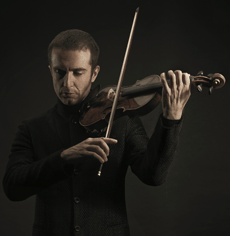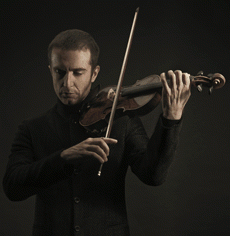
“Is this my time to be alive and free?” That was the first intelligible question posed by soprano Marie Plette in her impassioned but often incomprehensible rendition of The Promise of Time, a new song cycle by contemporary composer David Carlson. The work, part of the Magnum Opus project for new music, was performed Saturday by the Santa Rosa Symphony in a concert that also featured standard repertoire by Jean Sibelius: the Violin Concerto (with soloist Tedi Papavrami) and the Symphony No. 5.
The Carlson cycle, which consists of three songs with lyrics by poet Susan Kinsolving, offered an energetic beginning to the concert, with bright triplets and quintuplets propelling the orchestra forward. Plette entered forcefully, her powerful voice projecting well throughout the auditorium’s murky acoustics. She is clearly an operatic singer, with a pronounced vibrato and enough lung power to scare off the most nefarious villain. Unfortunately, the words she sang were often hard to discern.
Who to blame for the lack of intelligibility — the singer, the conductor, the orchestra, the composer, the librettist? All contributed, in one way or another. Plette was most intelligible on short, self-contained phrases, particularly when Music Director Bruno Ferrandis signaled the orchestra to back off. When she neared the top of her range, however, the words became less distinct.
Perhaps the solution would be to install a supertitle screen, or at least to leave the auditorium lights on so the audience can follow the text supplied with their programs. With those features in place, the performance might have been more rewarding. Carlson’s music, while firmly traditional, is often compelling, particularly in the “Velocity” song in the middle of the cycle. Here there was no doubt about the oft-repeated main word — velocity — and its musical equivalent.
Another type of intelligibility problem marred the performance of the Sibelius Violin Concerto. Albanian soloist Tedi Papavrami is a violinist of dazzling technical proficiency, able to nail the most treacherous double-stops, high notes, and fingerboard-spanning runs. He also has a luscious tone, particularly on the G string, where he returned again and again to bathe the auditorium in honeyed sound.
Where Papavrami fell short, however, was in his connection with orchestra and conductor. He stood ramrod straight at the front of the stage, with Ferrandis barely in his peripheral vision, and never once turned to face the orchestra. His sound projected well, but it never gelled with that of his fellow musicians. What emerged was more of an extended solo than a fully realized concerto.
The performance was riveting at times, particularly at the beginning of the second movement, when Papavrami played the entire opening passage on the G string, shifting seamlessly from top to bottom. The outer movements were sluggish in comparison. Ferrandis’ tempos were often too slow, and the result frequently lacked the necessary swing.
Despite these problems, the audience greeted Papavrami with a boisterous ovation, and after two curtain calls he launched into the Ballade by 19th-century violin virtuoso Eugene Ysaÿe. The Sibelius may be difficult to play, but the Ysaÿe is practically impossible, with an unending volley of harmonics, hemidemisemiquavers, and acrobatic bowing. Papavrami tossed all this off with ease, utterly confident in his technical ability.
Orchestra to the Fore
Sibelius returned in the second half, in the form of his Symphony No. 5. Here at last the orchestra could come to the foreground, with nimble playing from its many sections. Their distinct sonic qualities are a key feature of Sibelius’ austere score, which often foregrounds individual woodwinds and brass against relatively simple accompaniment.
After an unsteady opening from the French horns, the first movement solidified with the entry of the strings, who produced a clean sound with distinct lines. Their long buildup climaxed in a stringendo passage with a wonderful bassoon solo. As more players joined the mix, a convincing narrative emerged. Ferrandis sprang to life, becoming more and more agitated as the orchestra hurtled toward a rollicking ending.
The French horns began the slow second movement, as well, this time with more confidence. Restraint was the order of the day, with each voice again distinct, particularly the flutes, who leaned into the score’s frequent dissonances before sweetly resolving them. The austerity of the instrumentation led to a fine dramatic tension, well-sustained until the final interchange between strings and woodwinds.
Unlike most symphonies, the Sibelius No. 5 has only three movements, another sign of its innovations. As usual, however, the last movement is Allegro, here with a molto appended to speed things up. Much of the speed falls on the strings, who in this case displayed excellent unison while playing long stretches of 16th notes. The movement seemed to drift in the middle, but a long crescendo featuring the various brass sections brought the work to a satisfying close. To answer the question posed by Plette at the beginning of the concert, it was a great time to be alive and free.

